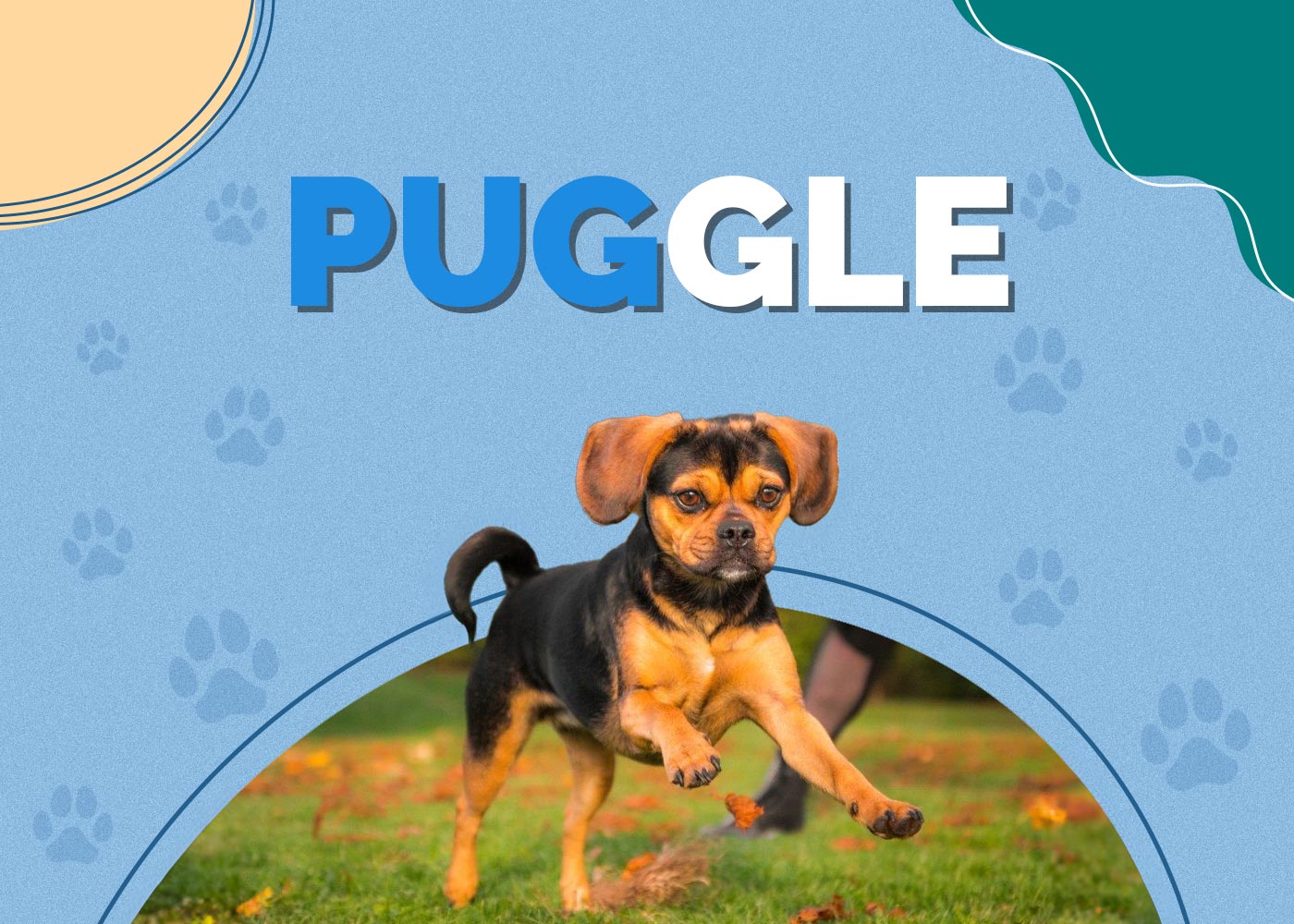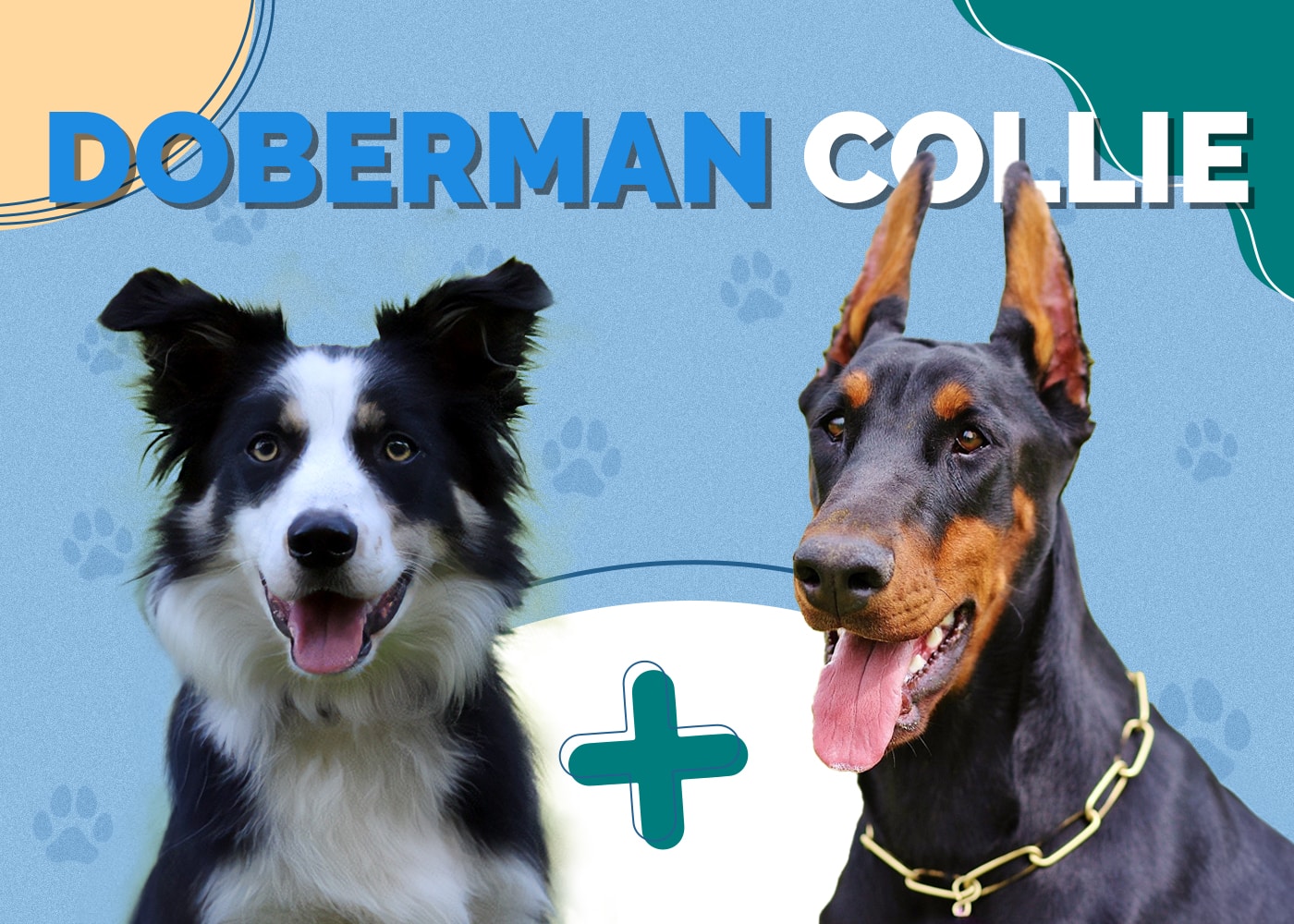Red Heeler: Pictures, Care, Temperament & Traits

Updated on
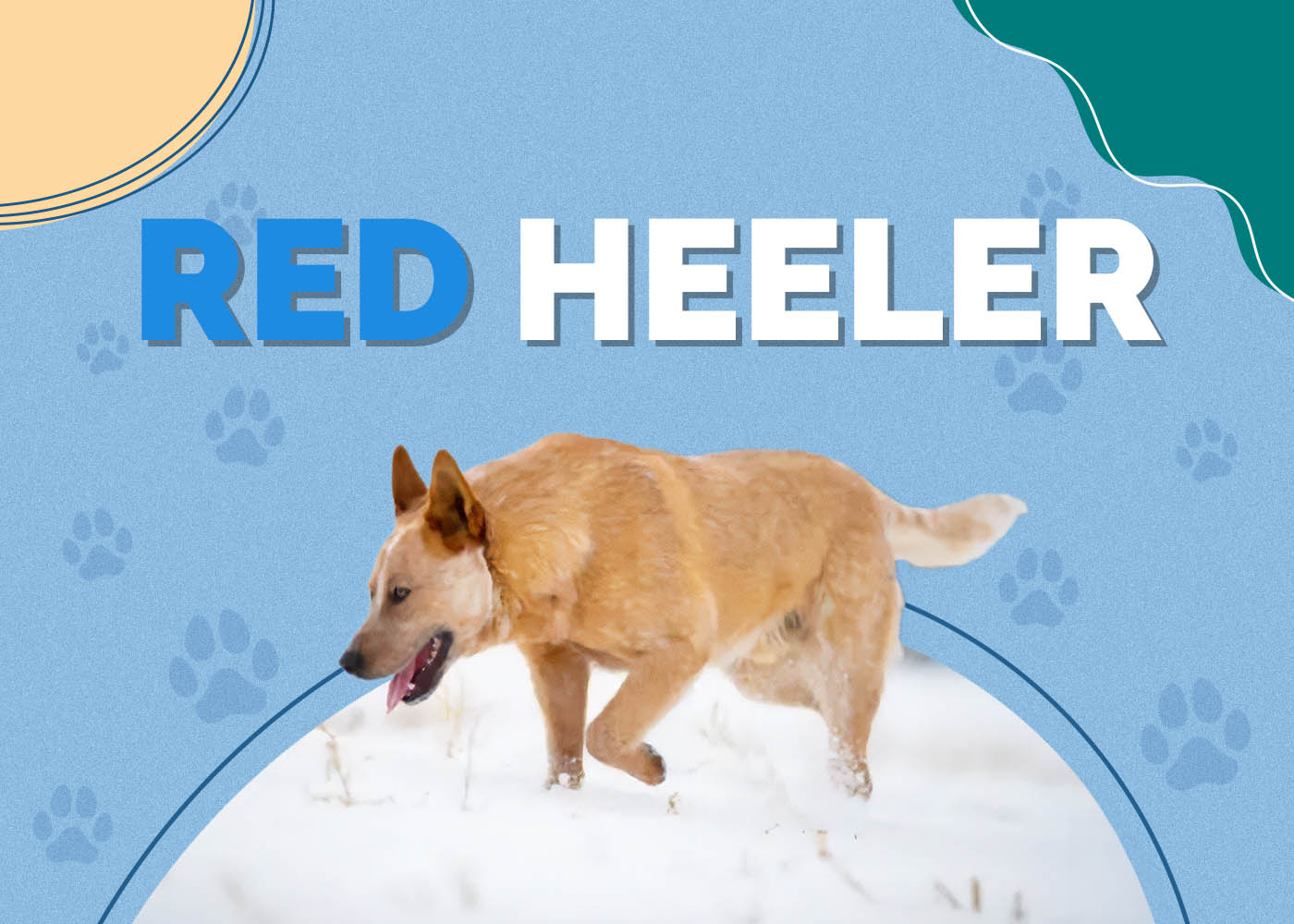
| Height: | 17-20 inches |
| Weight: | 30-45 pounds |
| Lifespan: | 11-15 years |
| Colors: | Brown and white, red |
| Suitable for: | Families, farmers, active adults |
| Temperament: | Intelligent, brave, agile, energetic, loyal, active, sturdy, protective |
The Red Heeler, perhaps best known by the common name “Australian Cattle Dog,” is a herding and farming dog that hails from New South Wales in Australia. These dogs were developed by early settlers for herding large massive amounts of cattle on large farms and are still used primarily as a working dog today. As you’d expect from a dog with this kind of history, they are full of energy and stamina and consequently need a ton of exercise to stay happy and healthy.
Red Heelers get the “Heeler” part of their name from their habit of nipping at the hooves of cattle to herd them, and the “Red” part comes from their unique and dense brown and white coat that gives an overall red appearance. With a history of working so closely with humans, these dogs are both highly loyal and attached to their owners and they thrive off of having a specific job to do.
If this unique and high-energy pooch sounds like the breed for you, read on for an in-depth look at this herding breed from down under.
Red Heeler Puppies
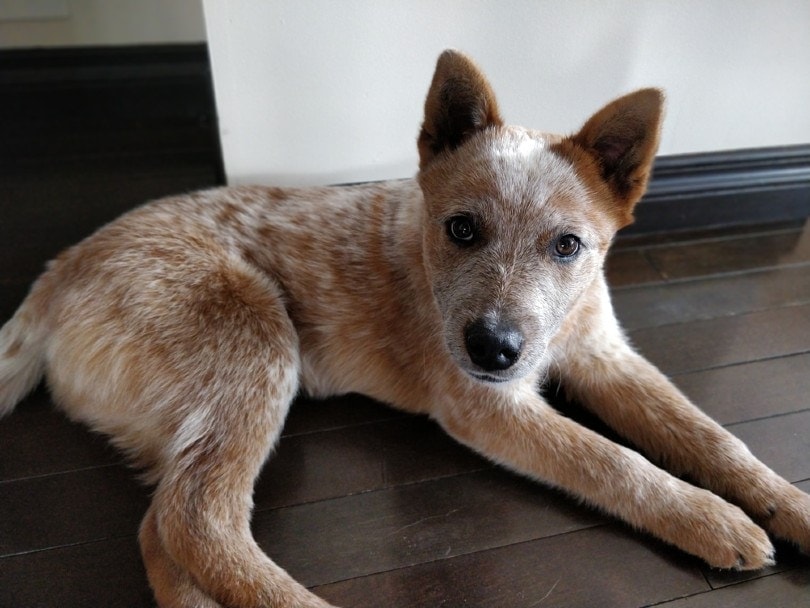
Before bringing home a Red Heeler puppy, you should carefully consider the fact that these dogs have unbelievable amounts of stamina and energy, and it will take a lot to tire them out. You’ll need to devote several hours a day to exercising this pooch if you are not putting them to work on the farm, and this is a massive responsibility. These dogs are highly accustomed to working hard, so without this regular stimulation, they can swiftly become bored, leading to destructive behavior and even aggression.
They are fairly low-maintenance pooches, though, and easy to groom. If you are up for the massive exercise requirements, they make a wonderful family pooch!
3 Little-Known Facts About the Red Heeler
1. They Are Descended From Dingoes
Early settlers in Australia needed a herding dog that could withstand the harsh, hot temperatures of the Australian bush, and traditional herding breeds like Collies had long coats that could not withstand the heat. These early dogs were crossed with Dingoes to allow them to be more tolerant of the intense heat and were later crossed with other breeds including Dalmatians, Border Collies, and Kelpies.
2. Red Heelers Are Born White
Known for their distinctive red, and sometimes blue, coats, a surprising fact is that all Red Heeler puppies are born completely white! This is likely due to their Dalmatian genetics, but they start getting their colors quickly. And by around 6 weeks, their patterns are visible.
3. Red Heelers Go By Several Different Monikers
In their native land of Australia, these dogs are commonly known as Red Heelers, but the breed has several other common names too. Officially, the American Kennel Club (AKC) recognizes them as the Australian Cattle Dog, but they are also known as Blue Heelers, Queensland Heelers, or Halls Heeler — depending on who you ask!
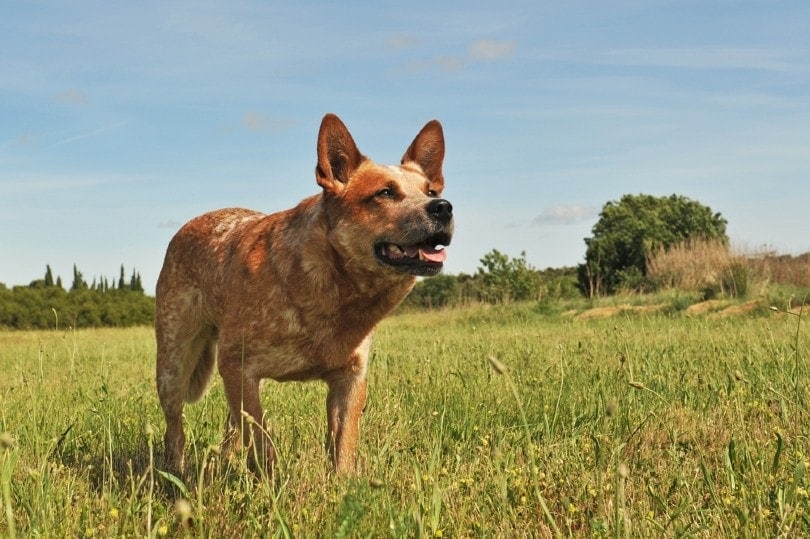
Temperament & Intelligence of Red Heelers 🧠
Red Heelers are high-energy working dogs that are known for their independent and sometimes aloof personalities. While they are incredibly loyal dogs that are highly protective of their family, they have an independent nature and inherent weariness of strangers, making them excellent guard dogs. These dogs need almost constant mental and physical stimulation, making them a difficult breed to own if not put to work. They are not a breed for novices, as they need a ton of training, exercise, and stimulation. Without adequate stimulation, these dogs can swiftly become destructive, chewing up everything they can get a hold of!
While these dogs are fairly reserved and aloof around strangers, they are exceedingly loyal and loving toward their owners and form strong bonds with their human family. They do not enjoy being far from their owners for extended periods and will again resort to destructive behavior as an outlet for their separation anxiety. If you are away from home a lot and cannot take your Heeler with you, this is unfortunately not the breed for you.
Are These Dogs Good for Families? 🏡
Red Heelers can make great family dogs if trained, exercised, and socialized properly. Like most herding breeds, they may have the tendency to try and “herd” children and other family members in the home, which includes nipping and chasing them. When these dogs are put to work with specific jobs to do and are trained well, they can make excellent family pets; however, anything less than that can result in some troublesome behavior.
Does This Breed Get Along with Other Pets? 🐶 😽
Again, with proper training and socialization, Red Heelers are typically fine with other dogs and usually make close friends with them. They have a powerful prey drive though, and this can be a real issue for the family cat! With early socialization, this can be largely avoided, but they’ll likely always have this hunting instinct, making them better suited as the only pet in the home.

Things to Know When Owning a Red Heeler:
Food & Diet Requirements 🦴
The Red Heeler has a ton of energy and as such needs a diet that compliments their incredible stamina and explosive bursts of energy. We recommend a diet high in animal-based protein to give them the energy they need to thrive. Dry kibble is great, and around 2-3 cups per day should suffice, ideally split into two or three meals to avoid bloat. This kibble should be high quality and free from any filler ingredients like wheat, corn, or soy, as they are fairly prone to getting overweight. They should not be free-fed for the same reason. Their food should ideally be at least 30% protein and around 15-20% fat, as these are the building blocks of energy they need to thrive.
We recommend supplementing their dry food diet with lean meats, organ meats, or high-quality tinned food every other day too. This will not only give them some welcome variety but some beneficial amino acids and vitamins too.
Remember that feeding your Heeler will depend a lot on their unique energy levels, their size, and their age. The diet you feed them should be age-appropriate and specially developed for puppies, adults, and seniors, but being such active pooches, their diet should be as nutrient-dense as possible, no matter their age.
Exercise 🐕
As you may have surmised by now, Red Heelers are extremely energetic dogs that need a great deal of exercise to stay happy and healthy. These dogs are not couch potatoes happy to snuggle their owners all day; they are working animals that need a job to do. If you have a Red Heeler employed as a regular worker on your farm, their energy needs are very likely being met, and they are doing what they love most.
However, if you don’t have a Heeler for working purposes, you’ll need to keep them both mentally and physically stimulated on a daily basis to avoid bad behavior. These energetic and active dogs will need at least 1-2 hours of exercise per day, but the more the better. They’ll love activities like obedience and agility training as it gives them directed purpose, as well as interactive games like fetch and frisbee. They make great running and jogging partners and are an ideal dog for owners who love the outdoors. Off-leash exercise is also highly recommended, so good training is essential to allow them this freedom.

Training 🦮
These dogs are highly intelligent, have a long history of working closely with humans, and are extremely loyal, all of which makes them fairly easy to train. With their working heritage and keenness to learn new skills, they are exceptionally fast learners, and with the right set of methods can be trained quickly.
Because these dogs are so loyal and need to be close to their owners, positive reinforcement methods are the best forms of training. For these dogs, reprimands and separation from their owners are the worst forms of punishment, so they do not respond well to harsh training methods. These methods reward good behavior with praise and treats, and since these dogs are so intent on impressing their owners, they’ll respond well to this form of training.
Heelers have a reputation for being somewhat stubborn and aloof at times, making training difficult for novice and inexperienced owners. However, for owners with experience, this is usually not an issue.
Grooming ✂️
Red Heelers have a thick double coat; a thick, dense undercoat topped with a straight and stiff outer coat. They are not heavy shedders, although will have a “blowout” of their coat twice a year during seasonal changes. They’ll need a lot of brushing during this time to remove any dead hair and save you from hours of vacuuming! Other than that, these dogs are a breeze to maintain, and occasional nail clipping and teeth brushing is all that’s needed.
Health and Conditions ❤️
Red Heelers are an old and relatively healthy breed that very few genetic health concerns to be aware of. But like all breeds, they are prone to certain health conditions, including hip and elbow dysplasia, deafness, and progressive retinal trophy.
Osteochondrosis dissecans (OCD) is the main concern to be aware of with the breed. This inflammatory condition is characterized by abnormal development of the dog’s bones, typically the shoulder joint, knees, or elbows.
- Obesity
- Skin allergies
- Deafness
- Progressive Retinal atrophy
- Hip and elbow dysplasia
- Osteochondritis dissecans
Male vs Female
If you have decided that the Red Heeler is the breed for you, the last decision to make is whether to bring home a male or female. While there is little difference between the two, and a dog’s personality can vary widely even among the same sex, there are a few differences to be aware of.
Males are typically larger and more muscular and are known to be more territorial and aggressive at times. Females are known to be clingier and tend to bond with and become attached to one owner. Males tend to mature slower, which may present as a challenge during training.
With all that said, choosing between a male and a female is really a case of personal preference, and the differences between the two are largely anecdotal. We recommend neutering males and spaying females, as this will prevent unwanted wandering and pregnancies, plus will usually even out their temperament. Remember that your dog’s personality and character is influenced far more by their training, environment, and unique upbringing than their gender.
Final Thoughts
The Red Heeler is the ideal working breed. These dogs have spent centuries working closely with their owners and are one of the most proficient working breeds out there. With this long working history comes a ton of energy and stamina, a trait that can be a challenge for owners who live in small homes or are not putting their Heeler to work. Provided they get adequate training and exercise, they make loyal, loving, and protective family dogs and expert guard dogs. While they can be territorial and protective at times, they are rarely aggressive and are a great breed to have around older children.
If you are looking for a dog to put to work on a farm or you are simply a lover of the outdoors and need a buddy to hit the trails with, the Red Heeler is a great choice!
Featured Image Credit by: AlexisM, Shutterstock





